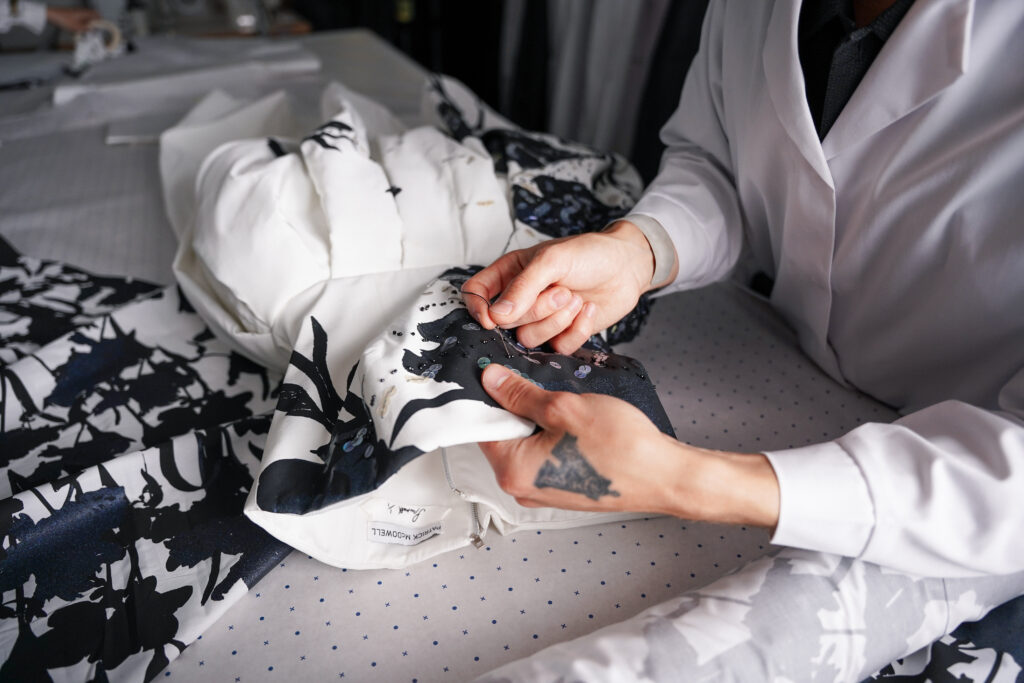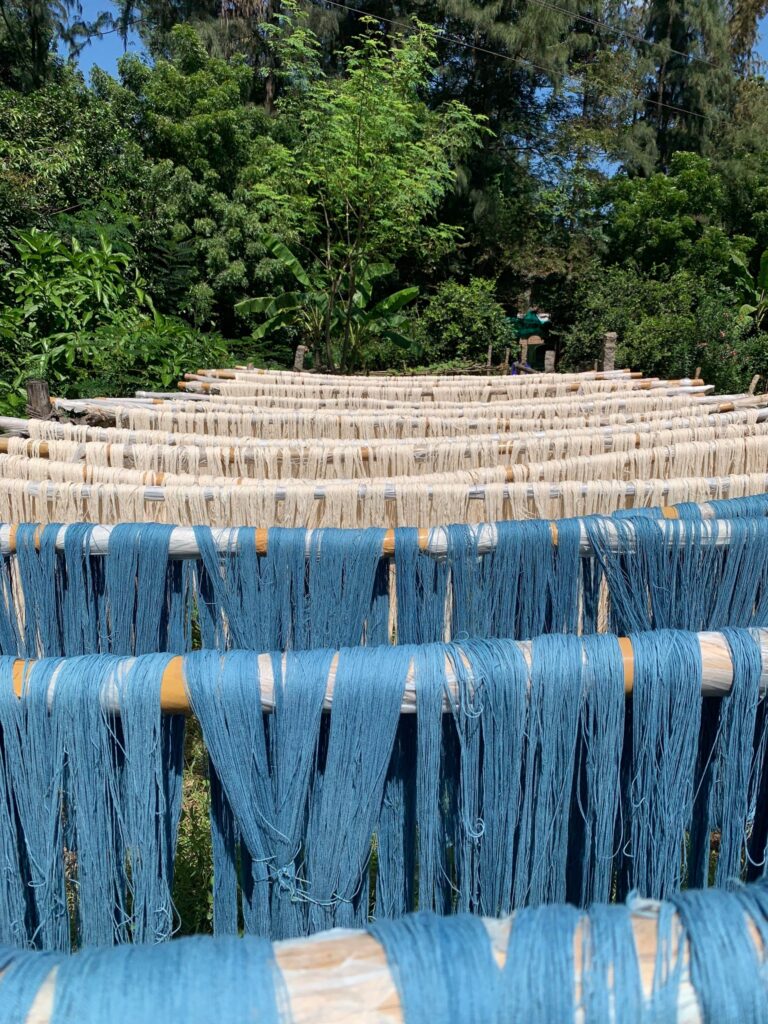Colour isn’t just a matter of taste – it’s a matter of toxicity. Synthetic, carcinogenic colour is killing us, and it’s killing the planet too.
Nowhere is this more relevant than fashion, where 800,000 tonnes of dye is used every single year and 90% of all clothing is dyed synthetically, using around two thirds of all dye produced.
In just one example, synthesised indigo contains formaldehyde, aniline and hydrogen cyanide. All chemicals which, in any other context, we would know to stay well away from. Yet we put them on our skin.
Why?
Dr Benjamin Droguet, Founder & CEO of next-gen pigment innovator Sparxell, speaking exclusively to Eco Age, explained: “The fundamental chemistry behind the colours in our daily lives hasn’t evolved since the 19th century. We’re still relying on the same toxic dyes, mined metals, and mineral-based pigments that were developed at the beginning of the Industrial Revolution,
The talk of London’s recent Future Fabrics Expo, Droguet’s company isn’t just opining on the problem – it’s producing the solution.
Sparxell’s collaboration with designer Patrick McDowell is proof not only that plant-based pigments are effective, but also that they’re beautiful and desirable on an aesthetic level.

“Pigments and dyes are foundational to fashion,” notes Julie Verdich, Director of Partnerships and Product at Octarine Bio, a Danish innovator in the space. “They shape aesthetics, identity, and desirability — but the way we produce and use them hasn’t meaningfully changed in over a century.”
It’s a familiar story where fashion is concerned, petrochemical materials having become the industry standard and a sustainability scourge.
When it comes to pigment, however, the problem is much less widely discussed. And, on the rare occasions that the issue is given airtime, the focus is often on the ultra-pervasive Carbon Black.
“Carbon Black is a heavy petroleum burned at really high temperatures. It’s essentially soot from oil. “It’s a great colorant for things like paints, plastics, inks and cosmetics.” explains Scott Fulbright, CEO and Founder of algae dye innovator Living Ink.
It is also a known carcinogen and the result of a resource-intensive and environmentally destructive process.
“Synthetic dyes are cheap, predictable, and industrial, which works if you’re trying to make hundreds of thousands of identical products.” – Saeed Al-Rubeyi, Story mfg. Co-Founder
By comparison, we rarely hear about how water from garment production is “returned” to nature, filled with heavy metals, powerful chemicals and microfibers. These polluted waters impact soil health, infiltrate and decimate waterways and are known to seriously harm wildlife.
“The global textiles and apparel sector utilises approximately a quarter of global chemical output, and upwards of 8,000 synthetic chemicals, across fibre, yarn, dyes, washes, finishes, and other upstream processes. Dyes themselves account for approximately one third of fashion’s upstream negative impact.”
For every tonne of textiles produced, 200 tonnes of water is used. Even after treatment, 90% of discharged dye reportedly remains chemically unchanged. “The textile industry,” Droguet adds, “uses over 10,000 different chemicals in colouration processes, releasing 1.5 million tonnes of toxic dyes into the environment annually.”
That’s poisoned water, coming right back to the planet and back to people. So, why isn’t it a priority?
“When people hear ‘plastic pollution,’ they immediately visualise tangible objects like bottles and bags,” Droguet agrees, “But people don’t think about what goes into creating that beautiful pair of blue trousers or that attractive gold and glossy wrapping. They see the end result, commoditised and standardised, not the chemical process behind it.”

Consumers, however, are just the final part of a long chain. Asked why switching up the pigment process in favour of more natural elements isn’t a fashion industry priority, Story mfg. co-founder Saeed Al-Rubeyi points to a systemic issue: “Because it’s hard, expensive, and slow. That’s everything most brands try to avoid. Synthetic dyes are cheap, predictable, and industrial, which works if you’re trying to make hundreds of thousands of identical products.”
Known for their “slow fashion” approach and a preference for working with what the planet has to offer, Story mfg. is committed to not following that same pattern: “We use natural dyes because they make sense: ethically, environmentally, and aesthetically.”
This same mentality led London-based Patrick McDowell to his collaboration with Sparxell: “We wanted to showcase the pigments in the most beautiful and compelling way so we created a beautiful one-off gown with a special floral placement highlighting the pigments link to the natural world.”
Droguet adds: “We’re replacing this outdated chemistry with bio-inspired solutions that work with nature rather than against it. Our bio-inspired approach harnesses the same structural colour principles found in nature (think butterfly wings and peacock feathers) – brilliant, vibrant colours that are completely non-toxic and biodegradable. It’s time the colour industry caught up with what nature perfected millions of years ago.”
For McDowell, though, it was most vital to “show the world that this innovation is available and accessible to the industry,” he says, highlighting the fact that meaningful change almost always comes from within.
“Pigments and dyes are foundational to fashion… They shape aesthetics, identity, and desirability — but the way we produce and use them hasn’t meaningfully changed in over a century.” – Julie Verdich, Director of Partnerships and Product, Octarine Bio
Designer and director Jeff Garner is well-versed in the problem of pigment. His documentary film, “Let Them Be Naked,” is a deep dive on this complex issue and one of very few such reports intended for the broad audience which most needs to hear it.
He told Eco Age: “There is a war at hand between the balance of the needs of the individual and the needs of the community, between selfish desires and stewardship – short term versus long term.”
Considering the potential for a more conscious framework, Garner adds: “Regulators of our fashion industry have applied the end-of-pipe solution, attempting to require the manufacturers to follow protocol… but this does not work. We need a solution on the front end: to reward companies for working to resolve and implement change themselves. Regulations are too hard to enforce and susceptible to corruption. If the design of the system was good, regulations wouldn’t be necessary. A new system needs to be put in place!”
In shifting the pressure onto the system and onto their peers this way, Garner, McDowell and their collaborators are setting both a precedent and a challenge.
The only question now is will they accept?
Karl Smith-Eloise is Features Director for Eco Age. He has worked as the EMEA Editorial Lead for HYPEBEAST and Editorial Director of FUTUREVVORLD, as a contributing editor to Highsnobiety, and for the fashion house FENDI. He now focuses exclusively on Earth-forward and ethical avenues in fashion, footwear and the broader culture.

